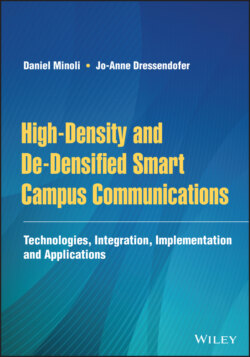Читать книгу High-Density and De-Densified Smart Campus Communications - Daniel Minoli - Страница 22
1.2.7 Pre‐pandemic/Long‐term Requirements for Dense Office Environments
ОглавлениеOffice space represents a major environment where work is accomplished in the United States and around the world. Data from the Commercial Buildings Energy Consumption Survey indicates that there were 5.6 million commercial buildings in the United States in 2012 (the most recent year for which data are available), spanning 87.4 billion ft2 of floorspace (see Figure 1.3) [13, 14]. The typical space allocation per employee is 130–150 ft2, although some lower‐end industries (e.g. retail) allocate less and some higher‐end industries (e.g. law firms) allocate more.
TABLE 1.9 Top Subway and Rapid Transit Systems in the United States
| System | Annual Ridership (2018) (M) | Avg. Weekday Ridership (K) | Stations (Approx.) | |
|---|---|---|---|---|
| 1. | New York City Subway | 2629 | 8765 | 470 |
| 2. | Washington Metro | 226 | 764 | 90 |
| 3. | Chicago “L” | 226 | 720 | 145 |
| 4. | MBTA, Boston | 156 | 510 | 50 |
| 5. | BART, Bay Area Rapid Transit | 126 | 417 | 46 |
| 6. | SEPTA Philadelphia | 94 | 328 | 75 |
| 7. | PATH NJ/NY | 92 | 310 | 13 |
| 8. | MARTA, Atlanta | 65 | 206 | 38 |
FIGURE 1.3 Inventory of US buildings.
Observers call out the need for tens of Tbps per square kilometer for traffic volume density. Using the data just cited, the requirement would be 3 connections per 100 ft2 (a VoIP connection, a LAN data connection, and a wireless connection) – this equates to 1 per 33 ft2. Conference rooms typically have higher concentration, say 20 connections in a 400 ft2 conference room, or 1 per 20 ft2; this motivates the need for space optimization and tools to address occupancy (for example, using occupancy sensors under desks, utilization sensors in meeting rooms, and comfort sensors in rooms and desk areas). Figure 1.4 depicts a heuristic model for office and conference room space allocations and costs. Requirements span voice, video, data, and IoT applications. It is expected that the number of IoT sensors will increase with time for smart lighting, smart building, and other automation functions. Thus, it would not be a stretch to reach a point in the near future, where a density of 1 connection per 10 ft2 is required for office environments.
FIGURE 1.4 Heuristic model for office space allocation.
